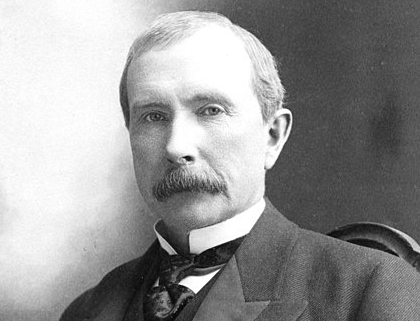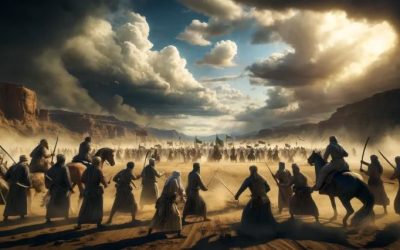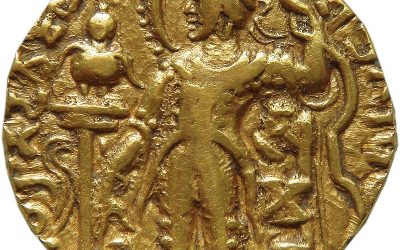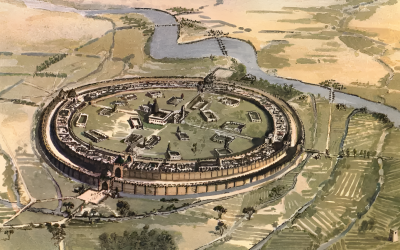Irfan Amin Patwary, Jahangirnagar University, Bangladesh
About 170 years ago in America, a 12-year-old boy lent his savings of $50 to a poor farmer. The dollars he earned raised turkeys with his mother, sold chocolates to friends, and worked for neighbors. On his mother’s request, he lends them to a farmer for one year at 7% profit. The farmer returned the dollar with a profit after a year. It affected him so much that, as an adult, he said, “It made me realize that it’s better to make money work for me than to work for money”.
That child later became the biggest businessman in America and the world. He wanted to live 100 years and own a million dollars. The first demand was not fulfilled for only 2 years. But he overcame his second wish and became the first billionaire in American history. His total wealth was about 400 billion dollars as of today. A businessman as influential and rich as him did not come even in almost 100 years of his death. He is John Davidson Rockefeller Sr., also known as John D. Rockefeller. He was the leader of Standard Oil Company, America’s largest oil company.
John D. Rockefeller was born on July 8, 1839 in Tioga County, New York. He was the second of six siblings. His father, William A. Rockefeller, was a traveling salesman. And mother Eliza Davidson Rockefeller was a very religious woman. He is named after his parents.
His father claimed to be a doctor and said he could cure cancer. But actually he was a very bad-tempered person. He actually went around selling homeopathy medicines. He had many wives and children in different cities, which John Rockefeller always kept secret. He was known as ‘Devil Bill’. However, John Rockefeller’s father contributed to his business knowledge. But his mother was the complete opposite of his father. As his father was away most of the year, his mother had to take care of the household expenses most of the time. He taught Rockefeller to work, save and give. He was very modest in nature.
His family did not stay in one place for long. First they moved to Moravia and then to Oswego, New York in 1851. There, Rockefeller enrolled in the Wego Academy School. He was very good at mathematics, which later helped him a lot in business. They moved to Cleveland, Ohio in 1853. Rockefeller attended Central High School there.
He studied at school till 1855 and dropped out. He later enrolled in a business course at Folsom Mercantile College. He completed the six-month course in three months. Then he started looking for a job. Get it once. On 26 September 1855 he joined a small firm called Hewitt & Tuttle as an assistant accountant. Later he was promoted as treasurer and accountant. He celebrated 26 September every year as ‘Job Day’ till his death.
But once he had a disagreement with his superiors about the remuneration, he left the job. Then he thought of setting up a business himself. Then he borrowed some of his two years’ savings and some from his father. Make neighbor Maurice Clark a business partner. While working as an accountant, he gained a reputation for skill and work. For this reason, he received a loan of four thousand dollars from the bank, which was incredible at that time!
They then worked as commission merchants. Commission merchants earn a percentage by selling various products for others. They started selling various products including grain, hay, meat. They earned $4,400 in 1860 and $17,000 in 1861. This business was very competitive back then. Rockefeller’s expertise is what makes them a successful business.
At this time, the civil war started across America. As the price of goods increases, so does their commission. Their business spread throughout Cleveland. Rockefeller was very hardworking. He did not want to make any concessions in business matters. Despite this success, he saw that the future of the commission business was not very bright. Through his visionary thinking, he realized that in the future, the business of industrial raw materials would be more profitable than agricultural products. That’s when he found a source of great potential – oil.
In 1859, Edwin Drake, an employee of the Pennsylvania Rockwell Company, discovered an oil field in Titusville, Pennsylvania. Drake then checked with a chemist at Yale University and found that the oil in the area was of very high quality. Later this area became known as oil area. Then a new business was opened by extracting oil from that mine.
Oil powered cars were not invented yet. But kerosene-powered lamps were used in many homes. Rockefeller reckoned that there was too much competition and business risk in oil extraction. He felt that oil refining business would be more profitable than oil extraction. Clark and his brothers were then joined by Samuel Andrews, who had experience in the oil refining business. John Rockefeller entered the world of oil with them in 1863 with ‘Andrews, Clark and Company’.
A new Pennsylvania railroad was then built with Cleveland. He built their oil refinery right next to the railway line. This gives them many advantages in oil transportation. Rockefeller’s success in the oil business continued. Meanwhile, the Clark brothers did not want to take a loan to expand the company, in 1865 John Rockefeller bought their share for $72,500. Then he named the company ‘Rockefeller & Andrews’. Then he got full freedom. Banks also used to give him money. He then expanded the company in every direction. At this time, he took many difficult decisions to increase the company’s quality.
In 1866 he opened another refinery in Cleveland with his brother William Rockefeller. He named it ‘Standard Works’. They also opened another office in New York City. He put his brother in charge there to take care of oil export. Their business is more successful abroad than at home. In 1867, Rockefeller made another man, Henry M. Flagger, his partner with Samuel. Then the new name of the company was ‘Rockefeller, Andrews & Flagger’. Flagger was a former acquaintance of Rockefeller. He once bought goods from him when he was a grain trader. He has a good relationship since then.
In 1868, their company became the largest oil refining company in the world. They knew that not only would oil refining be a profitable business, but also that waste materials would need to be used properly. Other refineries where waste oil dumped gasoline into rivers, Rockefeller turned them into fuel. He processed benzene and made it as a cleaner. Made candles from paraffin. Apart from this, wastes like naphtha and petroleum were also used for various purposes. These are what put them ahead of others. Rockefeller believed that one of the main conditions for success in business is to pay attention to every detail.
Rockefeller then continued to push rival companies out of his way. In 1865 his number of rivals was 26. He bought all but four companies within five years. The owners of these companies were lured to appoint them to higher positions in their companies. He was merciless in business. Rivals would threaten to shut down their business if they didn’t want to sell. Many times the price of the product was deliberately reduced, so that the competitors were harmed.
During this time, his business expanded a lot, and on January 10, 1870, he formed the ‘Standard Oil Company of Ohio’. He is the highest investor in the company with 30% shares. In 1872 he bought almost all the oil refineries in Cleveland. Then began buying refineries outside of Cleveland. By 1879, Standard Oil owned 90% of America’s oil refineries. 70% of it could export oil abroad. By then the business had expanded so much that Rockefeller could see only the company’s most important problems. At that time he was only 40 years old!
In 1882, Rockefeller formed the Standard Oil Trust. 40 local oil companies were patronized from here. Standard Oil’s headquarters were then built on Broadway. But at this time many criticisms of Rockefeller and his company began. They were accused of influence peddling and bribery to maintain their monopoly.
Railways were used to transport goods then. Railway owners had to pay for this. Rockefeller colluded with railroad owners to transport goods at very low prices. Other industrialists were outraged when this information came to light. Lawmakers also wanted to break up Standard Oil and eliminate its monopoly. Rockefeller became the most hated person in the media and newspaper pages.
In 1902, the daughter of an Ohio industrialist named Ida Tarbell brought out the dark side of Rockefeller in the book ‘The History of Standard Oil’. Rockefeller was also accused of employing spies in the offices of rivals. He suddenly became a villain to the labor leaders, politicians and people.
He was forced to go into hiding from the public. At this time all his hair fell due to great stress. In 1904, President Theodore Roosevelt announced that he would break up Standard Oil. Finally, in 1911, the US Supreme Court broke up Standard Oil into 34 companies. Today’s companies like Chevron, Esso, Mobil were once part of Standard Oil.
Despite so many accusations against him, he was very charitable in private life. He has spent around 500 million dollars on various humanitarian causes. When he met the children, he would give them a dime (a ten-cent coin). He gave to everyone, rich and poor. He donated 10% of his first income to the church. From then on, as his income increased, so did his donations to churches. He spent a lot not only for the church but also for education. Helped establish Spelman College for African-Americans. He also donated $80 million to the University of Chicago, which helped transform a small college into a world-class university. He himself said, it was the best investment of his life.
He donated $50 million to the Rockefeller Institute for Medical Research at his son’s request. Today it is known as Rockefeller University. In 1909, Rockefeller established the Sanitary Commission. This helped eradicate hookworm disease by 1927. In 1913 he formally established the Rockefeller Foundation. He paid about 250 million dollars.
This very gifted man died on May 23, 1937. He is buried in Lakeview, Cleveland. He is fondly remembered not only as a pioneer of the modern oil industry but also as a humanitarian.
References
- Kroll, L. (2011). John D. Rockefeller: A Biography. Greenwood Press.
- S. Supreme Court. (1911). Standard Oil Co. of New Jersey v. United States.
- Chernow, R. (1998). Titan: The Life of John D. Rockefeller, Sr. Random House.
- Yergin, D. (1991). The Prize: The Epic Quest for Oil, Money, and Power. Simon & Schuster.
- Hammond, B. (1957). Rockefeller: The Story of an American Phenomenon. Penguin Books.











